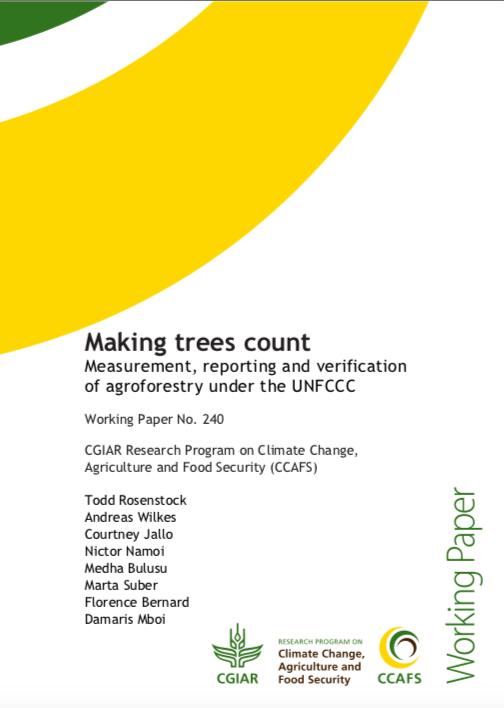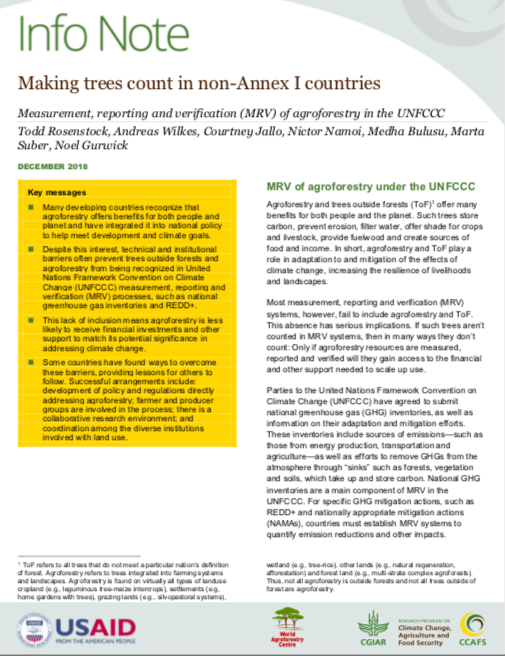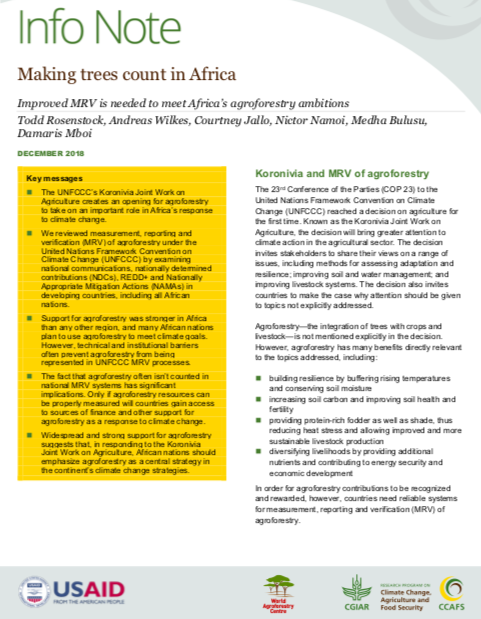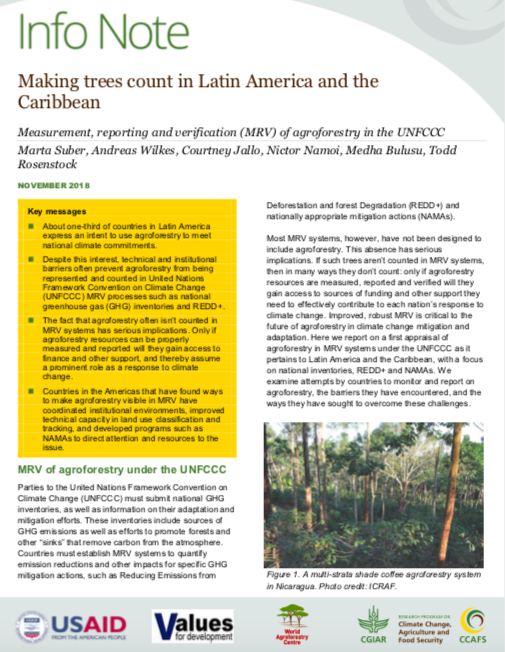Over a third of developing countries intend to mitigate climate change through agroforestry
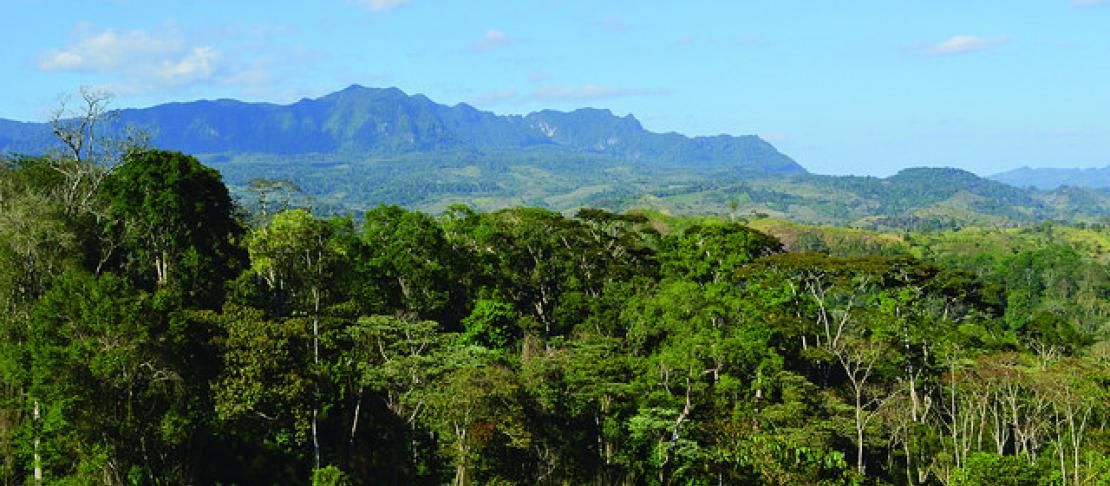
Improved accounting for agroforestry is needed immediately; may attract climate finance.
Agroforestry generates income, fuel, fodder and shade. Trees on farms buffer rising temperatures, filter rainwater, decrease soil erosion, conserve soil moisture, and increase soil health and fertility. And they sequester carbon. The practice of agroforestry thus helps farmers be more resilient and adaptable to changing growing conditions while also mitigating climate change.
As of June 2018, over a third (59 of 147) of developing countries had proposed agroforestry as a climate change mitigation activity to the United Nations Framework Convention on Climate Change (UNFCCC). However, despite intentions to expand agroforestry, significant gaps exist between countries’ ambitions and their capabilities to measure, report and verify (MRV) agroforestry actions, according to the recent report Making trees count: Measurement, reporting and verification of agroforestry under the UNFCCC.
“Not even one country systematically includes agroforestry in all of its relevant MRV systems,” said Todd Rosenstock, scientist with the World Agroforestry Centre (ICRAF) and lead author of the report. “We need to make sure accounting systems for trees on farms are science-based and effective if actions using agroforestry are going to be counted against goals,” Rosenstock said. “And with trees on farms, scientists and policy-makers have many decisions to make based on the technical ways to identify trees and institutional responsibilities in the country.”
Problems; potential solutions
The report describes institutional and technical hurdles faced by countries. Institutional hurdles include deciding which ministry is responsible for trees that occur on forest and agricultural lands (environmental or agricultural departments, for example) or finding financial resources and technical capacity to compile, process and store necessary data. Technical challenges include the need for new technology to measure agroforestry and figuring how and when their unique definitions of “forest” can be clarified to include agroforestry.
Filling a few key gaps would benefit countries across the globe.
- Cost-effective and lower-technology to represent agroforestry lands, including approaches that leverage freely available high-resolution imagery and local knowledge, such as Collect Earth.
- Systematic guidelines for how agroforestry can be addressed in national inventories and national communications.
- Practical methods for linking national and project-level MRV.
- More collaboration between countries and projects could reduce transaction costs and result in shared benefits.
Analyses in Africa and Latin America reveal region-specific opportunities
71% of African countries identified agroforestry as a climate change adaptation and mitigation solution in their climate change plans (Nationally Determined Contributions - NDCs). But no country is currently able to systematically track changes in agroforestry. Across the continent, there is a need to strengthen technical capacity to represent agroforestry in national inventories; develop and utilize Africa-specific data for carbon quantification of agroforestry; and use the Koronivia Platform to advocate for agroforestry implementation and MRV.
But there is not one road to improved accounting and implementation of agroforestry. Authors of the Info Note on agroforestry MRV in Africa describe how national context is important. Technical and institutional leverage points are likely to be different in each country, they say. For example, Ghana has developed distinct MRV systems for large-scale programs focusing on cocoa and shea that are designed to link to national UNFCCC-related systems. Other countries could employ similar planning and design processes.
In Latin America, agroforestry is core to shaded high-value perennial crops such as coffee and to cattle production systems. However, most national accounting and inventories do not address the cross-sectoral nature of agroforestry MRV, and expansion or improvements in agroforestry cannot be rigorously quantified in many current systems, according to the Info Note on agroforestry MRV in Latin America.
Experts in multiple countries said that increased use of high-resolution satellite imagery would make it easier to include agroforestry in national inventories. And Colombia is doing just that. By creating a time series for land-use transitions, Colombia moved from simple reporting of annual land-use classes to a land-use transition matrix. Analysis of the imagery also highlighted where significant uncertainties remain, thus providing the basis for future MRV improvements.
Action to beget finance and increase benefits for farmers and climate
Countries recognize agroforestry’s contributions to farmers’ food security and livelihoods will contribute to climate change mitigation efforts, food security, and livelihoods. While research shows how agroforestry is linked to climate change adaptation and mitigation, qualifying for climate finance to support efforts requires robust and scientifically sound MRV systems.
Funding for MRV efforts is needed to catalyze finance to support farmers to increase resilience and adaptation to climate change and to help countries meet their national ambitions and international commitments,... If agroforestry can’t be or isn’t counted, programs will put money elsewhere."
Todd Rosenstock, World Agroforestry Centre (ICRAF)
Read more:
- Working paper: Making trees count: Measurement, reporting and verification of agroforestry under the UNFCCC
- Info note: Making trees count in non-Annex I countries: Measurement, reporting and verification (MRV) of agroforestry in the UNFCCC
- Info note: Open- and crowd-sourced MRV for agroforestry?: Preliminary results and lessons learned from a pilot study using Collect Earth to identify agroforestry on multiple land uses in Viet Nam and Colombia
- Info note: Making trees count in Africa: Improved MRV is needed to meet Africa’s agroforestry ambitions (Also available in French)
- Info note: Making Trees Count in Latin America and the Caribbean: Measurement, reporting and verification (MRV) of agroforestry in the UNFCCC (Also available in Spanish)
- Report: Potential mitigation contribution from agroforestry to Viet Nam’s NDC
- Report: Potential mitigation contribution from coffee agroforestry in three regions of Viet Nam
Research was conducted through a collaboration among USAID Sustainable Landscapes, the CGIAR Research Program for Climate Change, Agriculture and Food Security (CCAFS) and the World Agroforestry Centre (ICRAF) and in partnership with multiple experts. Please see reports for co-authors and affiliations.
CCAFS is supported by the CGIAR Trust Fund and bilateral donors. For more information, please visit https://ccafs.cgiar.org/donors.
Julianna White is communications officer and program manager for CCAFS Low Emissions Development research.

